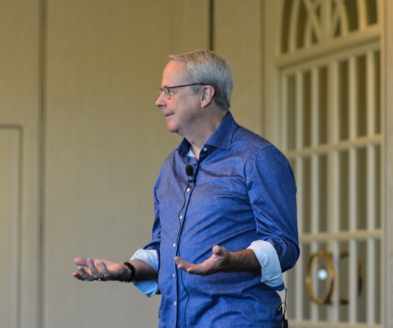People worldwide are discovering the Getting Things Done® methodology; and often I’m asked, “Where should I start with GTD?!” They have either read the book, been to a course, heard about it on a podcast or from a friend; and they have sufficient inspiration or at least curiosity to test it out. But because there are multiple aspects and components of the GTD approach, they’re feeling a bit lost about how to engage, to begin with.
It’s also a question posed by people who have seriously “fallen off the wagon” in their GTD practices. They’ve tasted the delicious aspects of stress-free productivity the process provides, but things have slipped, and they’ve fallen back into the experience of unclarity and overwhelm. “How can I best get back on?!”
For anyone and everyone in either of the above categories, I have a very strict and specific procedure that must be followed, without exception. If followed, it’s a guarantee of success. If not, well… good luck.
Where, exactly, should you start?
(Hang on, this is going to be tough…)
Start anywhere.
Yes, anywhere. Any portion or component of the GTD approach, applied, will bring at least a bit more clarity, focus, and control for you—without exception. And very likely when any one thing is executed, it will create a reverberation effect and spread to other parts. It’s a holistic model—i.e. any piece can be worked, and it will add to the whole gestalt.
Capture what’s grabbing your attention. Simply decide the very next action on anything you need to be making progress on. Clean a closet. Allow yourself to fantasize where and how you’d like to be, five years from now. Any of those actions (or a hundred more) could prime your pump to engage in some next step.
That said, one cool starting point would be to go through Part 2 of the book Getting Things Done, which serves as a hands-on instruction manual, step-by-step, walking you through the implementation of GTD. Of course, you could hire a David Allen Academy certified coach who can do the same thing (virtually or in person), with the added impetus of having someone right with you, holding you to and through the process (think: personal trainer in your gym).
But if those are not options for you right now, I’ve listed below some typically great starting points. I’ve used each of them many times both for myself and for clients and friends. There’s no danger here—nothing about GTD is like running with scissors! It’s all good stuff.
Take your pick
Write down what’s on your mind. This is an obvious one, if you’re familiar with GTD at all. But for beginners and even sophisticated practitioners, it’s a recurring refrain: unload! Even if you take a mere three minutes and jot down the top-of-mind things rattling around in there, you’re doing great.
Clean a drawer. No kidding. It’s one of the best therapies in the world for getting back in your psychological driver’s seat. And, unless you just moved into a new place this morning, there is always a drawer to clean.
Get a piece of cool gear. A new notepad, a fountain pen or slick-writing ballpoint, some new app you saw someone using really productively, a shredder, a labeler, an executive-like in-tray, plastic folders or envelopes…whatever floats your boat that indicates better or more capturing or organizing. Good toys can be magical in this regard.
Tackle one pile. There’s likely at least one stack of stuff somewhere in your environment that you’ve gone somewhat numb to, but you know it contains things to be sorted and organized—trashed, filed, or curated for next actions or projects.
Delete one email folder. Surely there’s at least one that is outdated that you can dump.
Purge a filing drawer. Similar to, but a bit more rigorous than dealing with a pile, this can often make a big dent in getting your act more together. Everything in your drawers and filing containers belonged there at one time, but time itself changes the meaning of much of it. Crap self-generates, it doesn’t self-destruct.
Do a two-minute-action walk-around. Get up and walk around your office or home looking for anything that needs doing that you can use the two-minute rule for. Change the light bulb. Tighten that whatever with a screwdriver. Raise or lower a seat. Straighten that painting. Put those boots where they really belong.
Define and take the next action on one new cool thing to do. A vacation spot to explore, a creative pastime to start, a special event to put together.
Celebrate the easy wins
All of these (and many more) would be part of a full GTD implementation, in any case. And, if doing any of these kinds of activities starts to get your productivity juices flowing, it would be wise to channel that energy into some next level in your capturing, clarifying, organizing, reflecting, and engaging practices. We all need to make sure we’ve lowered the bar sufficiently to get going, on anything. Then we celebrate the easy wins and move forward to the bigger ones.
This essay appeared in David Allen’s Productive Living Newsletter. Subscribe for free here.



Recent Comments